Hoi An

Hoi An is a town with rich historical and cultural past. Located in Vietnam, it is south of Da Nang. The most convenient way to get to the UNESCO World Heritage city is to land at the nearest airport in the city of Da Nang. From the airport to old town is a road of about 45 minutes by car.
The unique architecture in Hoi An is a consequence of the fact that in the 16th and 17th century, the city was a major international port where European ships supplied lead, sulfur and weapons, but at departure from here, were loaded with spices, oils, silk and porcelain. Although shipping and trade went well here, the port moved to Danang. As a result, many foreigners arrived by commercial ships along Tu Bon River, landed here on the local port Fo Fay, today the buildings of Hoi An have famous prints of the Japanese, Vietnamese, European, Chinese architectural styles.

Perhaps the biggest attraction here is the Japanese covered bridge, which is a kind of emblem of Hoi An. On it are built several temples, most famous of which is the Taoist one. The bridge was built around 1600 by a Japanese community living here. Only 40 years after the bridge was ready, however, its makers were forced to leave their homes because of the local strict policy of Japan's Tokugawa shoguns.
Besides the religious buildings, there are beautiful Chinese family chapels.

The two dominant cultures in the past centuries here were Japanese and Chinese. In the mid-18th century, the Japanese shogun stopped international trade, thereby reducing the Japanese influence in Hoi An. However, Chinese immigrants were becoming more and more numerous.
Trade allows many of them to prosper and build beautiful homes and temples. Among these temples were built the various Chinese communities, as well as rooms for religious rituals. These rooms feature a colorful interior and exterior and roofing tiles are smooth, colored in bright green. Internal walls have lavish ornamentation of drawings and engravings of dragons and mythical creatures.















